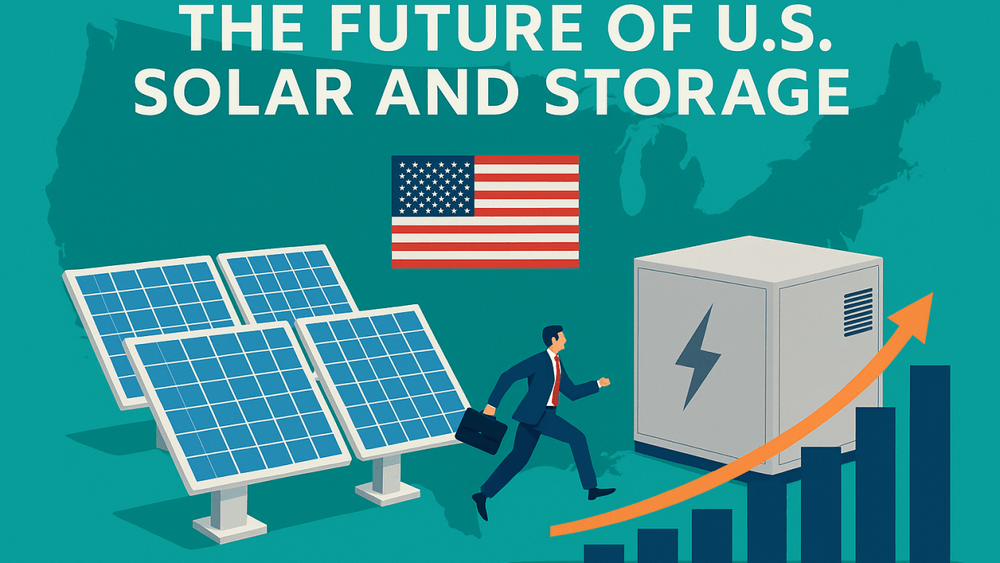Last week’s signing of the so-called One Big Beautiful Bill by President Trump has reshaped the cleantech landscape in the U.S. -again. While the rhetoric might be grand, the fine print tells a more sobering story for solar and wind developers. Tax credits are being pulled back, timelines shortened, and uncertainties around enforcement layered in. Meanwhile, energy storage has quietly emerged as the sector’s strategic safe harbour.
We’ve seen this moment coming. In our soon-to-be-published Q2 Market & Talent Review, one theme stood out across Europe and the U.S.: momentum is a strategy. The clock is ticking; not just for the climate, but for investors, developers, and leadership teams deciding how and where to act.
Solar: The U.S. Hits the Brakes!
Let’s be clear: solar just got harder in America. The 25D residential solar credit ends in 2025. The 48E and 45Y credits have tighter eligibility rules and compressed timelines. Projects must begin construction before mid-2026 to retain full benefits—and then be completed within four years.
That’s triggering a pre-2026 gold rush. Developers are accelerating starts, locking in supply chains, and—critically—scrambling for leadership talent with policy navigation and project finance experience. We’re already seeing a spike in demand for C-level and VP-level candidates who can operate at speed under pressure. We such a gold rush in the UK after solar policy changes back in 2011/12. A lot of grey hair and wrinkles came of it, but a massive amount of solar was deployed very quickly.
But after that window closes? A potential cliff edge. Fewer incentives. Less clarity. And likely, fewer projects moving forward. Until a change of administration, or geopolitics!
Energy Storage: Quiet Resilience
Storage, on the other hand, remains remarkably intact. In fact, it may be the surprise winner. The Investment Tax Credit (ITC) applies to standalone projects and isn’t restricted by the same FEOC (foreign entity of concern) rules or phaseout timelines.
This matters. With grid fragility a growing concern—highlighted by blackouts in Spain and rising curtailment risk in the U.S.—storage is now non-negotiable infrastructure. Our Q2 report highlighted surging storage approvals and deals in the UK, Germany, and Italy, while utility-scale BESS remains a top hiring category across Europe.
And it’s not just deployment. Talent demand in storage is holding strong: strategy leaders, grid specialists, and commercial scale-up execs are still in short supply.
What This Means for Capital - and Talent
Capital will follow clarity. Some VCs and infrastructure funds will double down on U.S. storage and behind-the-meter resilience plays. Others will pivot capital and hiring activity toward Europe, where the policy and funding environment remains ambitious, stable, and talent-hungry.
From our Group's offices in Energy Capital Houston and Financial Capital New York, we’re seeing first hand how developers and investors are repositioning. Meanwhile, our European team is fielding interest from senior U.S. cleantech talent looking to test the waters in Germany, the Netherlands, and the UK.
And that’s the bigger point: the global flow of top-tier cleantech talent is in flux. Not because people are leaving the mission, but because they want to be where they can have the biggest impact, with the least political whiplash.
Momentum Is a Strategy - and Talent Is the Lever
As we write in the opening of our Q2 Review: “The organisations moving with conviction and pace are the ones winning top talent, building culture, and staying ahead of the curve.” In markets like this, hiring slows - but becomes more consequential. Every strategically important or leadership hire becomes a lever. Every delay is magnified.
If there’s one lesson from both policy uncertainty and market pressure, it’s this:
The best talent wins. In the short-term race to get projects over the line. And in the long-term journey to navigate volatility, deliver returns, and build resilient cleantech businesses.
The U.S. still matters. Storage is strong. And solar still has a path forward; just a more complex one. But for companies on both sides of the Atlantic, this is no time to sit still.
We’ll be unpacking this more in an upcoming episode of the Leaders in Cleantech podcast - looking at what the U.S. policy shift means for project pipelines, capital flows, and talent migration.
Stay tuned - and if you're scaling or shifting strategy, let’s talk. Because in this market, clarity, speed, talent and leadership are your real advantage.
DM if you want an advance copy of our Q2 Market and Talent review.
David Hunt



